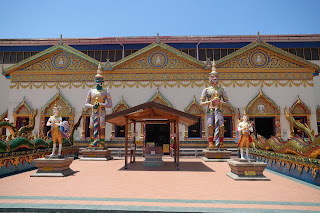Planes, trains, automobiles, oh and a ferry have been getting us around Malaysia. We took a 3 hour bullet train from KL to Butterworth before catching a 15 minute ferry across to George Town on the island of Penang. The train was quite a pleasant ride. We booked in business class and the seats were nice and roomy and comfortable. With this fare we were served a hot lunch and an additional snack closer to arrival. The connection to the ferry was easy and attached to the train station at Butterworth by a short covered walkway. We decided to split our time in George Town at two hotels located in different parts of the city. Our first hotel was a short walk from the ferry terminal and was well located in the older part of the city core.
George Town is a colourful, multicultural city, known for its British colonial buildings, street art, Chinese shophouses, mosques, and has gained the reputation as the gastronomical centre of Malaysia. There is no shortage of places to eat with food hawkers, food markets, and restaurants. The city centre was named a UNESCO World Heritage Site in 2008 and is where you find Fort Cornwallis, a bastion fort built by the British in the late 18th century. There isn’t much left to see at the site aside from some decommissioned cannons and some empty barracks. We did learn a bit of the fort and city’s history however which made the visit worth it. The Queen Victoria clock tower sits just outside the fort and was dedicated to three queen to commemorate her diamond jubilee. Just outside of the fort is Esplanade Padang Kota Lama, a large park great for gatherings and festivals. Impressive architectural buildings are found all around town including the city hall and town hall buildings. The Pinang Peranakan Mansion built in the late 1890s is a beautiful green mansion that was the former residence of the former residence of the Hai Sen secret society leader. Many buildings unfortunately have come under disrepair and appear to require significant investment to return them to their glory. The Sri Maha Mariamman Temple has the most vibrantly coloured sculptures of gods and goddesses adorning the main gate and facade.The large multicultural and religious influence is evident within the city. With Chinese, Indians, Siamese, Malays, Burmese, Arabs, and Europeans all represented in some fashion. The Little India quarter is the epicentre of Indian music, authentic clothing and jewellery shops, exotic spices, and savoury cuisine. We ended up having an Indian dinner one evening at a Michelin recommended restaurant called Sardaarji. The food here originates from the Punjab region in India and was such an explosion of flavours and amazing mixture of spices in every bite. A new food experience we tried was Burmese food. Our dishes were very flavourful and not too terribly spicy. This restaurant appeared to be run by a family and seemed to be more of a locals place, at least while we were there, there were no other tourists. Again no shortage of food options the biggest challenge being what to choose. We sampled as many traditional Malay dishes including Nasi Lemak, and curry dishes as possible.
Aside from being a foodie’s haven, George Town is also famously known for its street art. Art pieces can be found everywhere and some even include physical objects you can interact with like man riding motorcycle which has an actual motorcycle built into the piece that you can sit on. The vast number of art pieces include murals, metal sculptures, and wall paintings on almost every street corner within the city core. The art pieces are intended to reflect the daily lives of the people of Penang often depicted in a humorous and fun manner.
The city is a fairly walkable city though does not have the best sidewalk infrastructure so you are often walking along side traffic. When on a sidewalk you have to be on the lookout for motorists who are trying to bypass traffic. The easiest way around if you are going further than a few blocks is by Grab.
The Penang Botanic Gardens is a 30 hectare garden established in 1884. The garden today houses a rich variety of flora and fauna with some specific collections of plants like the fern collection, the herb garden, the cactus house and sun rockery. The most unusual and unique tree we saw was the cannonball tree. This tree looks like it is growing coconuts however these hard, woody round cannonball like shells contain a fruit which animals will consume. The tree also grows a beautiful flower. Watch out for wild monkeys, there are everywhere and for the most part leave you alone unless they feel you are threatening them some way which Z found out by taking one step too close to a baby. Mama hisses at him fiercely and probably would have lunged if he didn’t step back. They say never mess with wildlife!
The second part of our stay was in the Gurney area. This area is being converted into more of a commercial district filled with high rises, shopping malls and hotels surrounding some of the older traditional prewar houses and colonial bungalows that have not yet been redeveloped. Gurney Drive is a seafront promenade with large recreational park area, and ample walkways to stroll along the water. It’s famously known for the street cuisine and the seafront hawker’s centre. The area is still under development yet already provides the feel of an upscale area. Our stay here at the just opened (3 weeks in operation) Marriott was fantastic. We had a nicely appointed room with a lovely view of the promenade and waterfront below.
Next up is the island of Langkawi, a short 20 minute flight away.




No comments:
Post a Comment